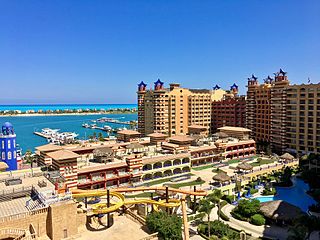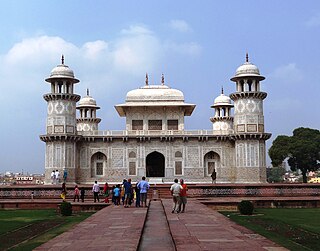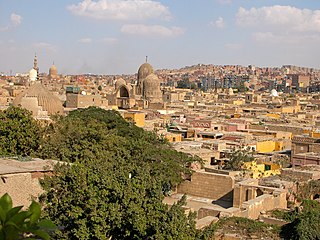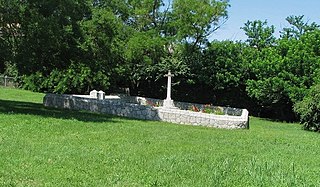
El Alamein is a town in the northern Matrouh Governorate of Egypt. Located on the Mediterranean Sea, it lies 106 kilometres (66 mi) west of Alexandria and 300 kilometres (186 mi) northwest of Cairo. The town is located on the site of the ancient city Antiphrai which was built by the Romans.(Greek: Ἀντίφραι).
These lists of cemeteries compile notable cemeteries, mausolea, and other places people are buried worldwide. Reasons for notability include their design, their history, and their interments.

A tomb or sepulcher is a repository for the remains of the dead. It is generally any structurally enclosed interment space or burial chamber, of varying sizes. Placing a corpse into a tomb can be called immurement, although this word mainly means entombing people alive, and is a method of final disposition, as an alternative to cremation or burial.

Brookwood Cemetery, also known as the London Necropolis, is a burial ground in Brookwood, Surrey, England. It is the largest cemetery in the United Kingdom and one of the largest in Europe. The cemetery is listed a Grade I site in the Register of Historic Parks and Gardens.

Rookwood Cemetery is a heritage-listed cemetery in Rookwood, Sydney, Australia. It is the largest necropolis in the Southern Hemisphere and is the world's largest remaining operating cemetery from the Victorian era. It is close to Lidcombe railway station about 17 kilometres (11 mi) west of the Sydney central business district. It was added to the New South Wales State Heritage Register on 2 April 1999.

The Bibliotheca Alexandrina (BA) is a major library and cultural center on the shore of the Mediterranean Sea in Alexandria, Egypt. It is a commemoration of the Library of Alexandria, once one of the largest libraries worldwide, which was lost in antiquity. The Bibliotheca Alexandrina contains books in classical Arabic, English, and French languages.

Senenmut was an 18th Dynasty ancient Egyptian architect and government official. His name translates literally as "brother of mother".

A war grave is a burial place for members of the armed forces or civilians who died during military campaigns or operations.
Nelson's Island is an island located in Abū Qīr Bay, off the coast of Alexandria, Egypt. It is a local site for picnics and recreation, and is the location of a group of British graves dating from the Napoleonic Wars. It was named after Horatio Nelson, the famous British admiral.

The Melbourne General Cemetery is a large necropolis located 3 km (1.9 mi) north of the city of Melbourne in the suburb of Carlton North.

A hypogeum or hypogaeum is an underground temple or tomb.

Sir Robert Stodart Lorimer, KBE was a prolific Scottish architect and furniture designer noted for his sensitive restorations of historic houses and castles, for new work in Scots Baronial and Gothic Revival styles, and for promotion of the Arts and Crafts movement.

El Qantara is a northeastern Egyptian city on both sides of the Suez Canal, in the Egyptian governorate of Ismailia, 160 kilometres (99 mi) northeast of Cairo and 50 kilometres (31 mi) south of Port Said. The two parts of the city are connected by a high-level fixed road bridge, the Mubarak Peace Bridge. The bridge makes a connection between the division of Africa, and Asia, making El Qantara a Border town.
El Nasr Girls' College (EGC) (Arabic: كلية النصر للبنات) is a school in Shatby, Alexandria, Egypt. It was established in 1935, and was originally known as English Girls College.

The City of the Dead, or Cairo Necropolis, also referred to as theQarafa, is a series of vast Islamic-era necropolises and cemeteries in Cairo, Egypt. They extend to the north and to the south of the Cairo Citadel, below the Mokattam Hills and outside the historic city walls, covering an area roughly 4 miles (6.4 km) long. They are included in the UNESCO World Heritage Site of "Historic Cairo".

Jack Lindsay Doubleday was an Australian rules footballer who played with University and Melbourne in the Victorian Football League.

The British passenger steam liner SS Leasowe Castle was built between 1915 and 1917 at Cammell Laird shipyards in Birkenhead.

The Commonwealth Military Cemetery is located in Niš, Serbia in the municipality of Palilula. It is listed as a Protected Cultural Monument of the Republic of Serbia. The cemetery's address is 1 Miladina Popovića Street, in the district of Delijski of Niš and approximately 500 metres from the Skull Tower. For that reason, it is also sometimes listed as Chele Kula Military Cemetery.
Annibale Evaristo Breccia was an Italian egyptologist, the second director of the Greco-Roman Museum of Alexandria and rector of the University of Pisa.

















